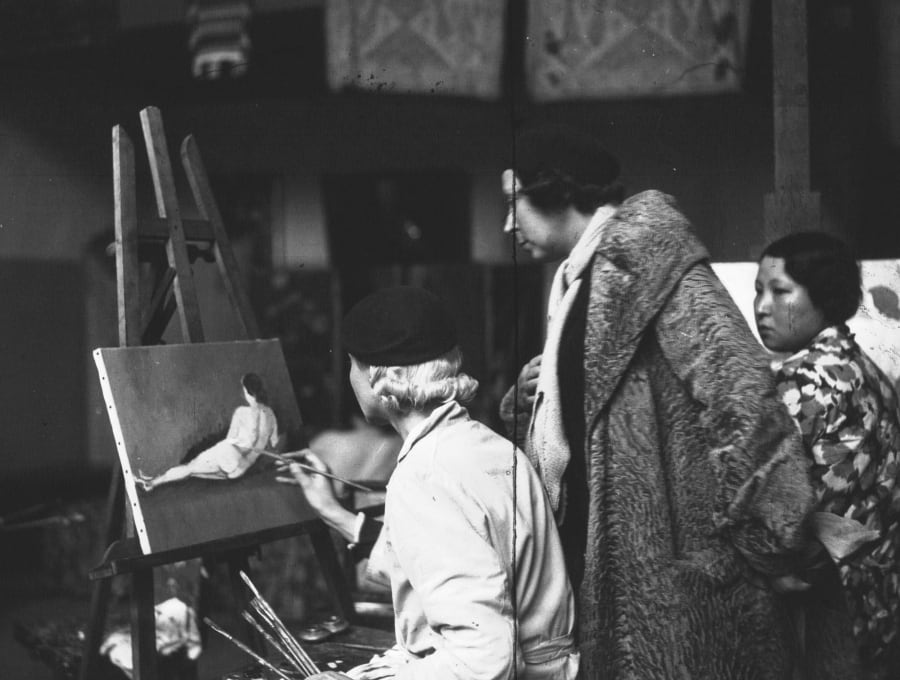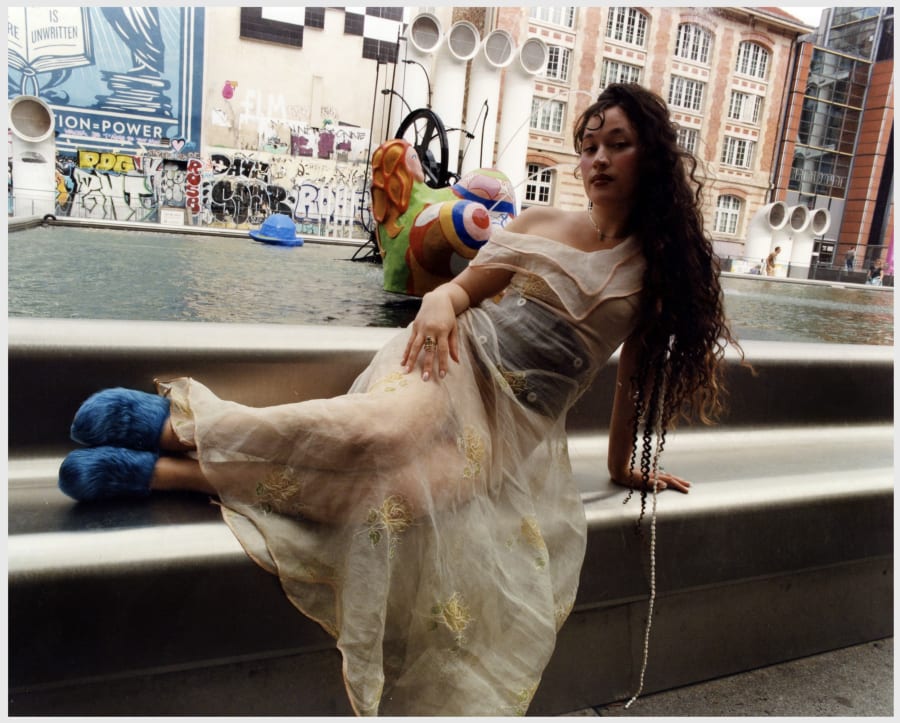常駐紐約的作家、藝術家和收藏家Kenny Schachter將自己的穿搭經驗總結為「嚴謹的統一性」。多年來,他的穿著風格始終如一:長袖襯衫、短袖襯衫,偶爾外加一件毛衣,搭配ASICS或New Balance運動鞋,系著紅金相間的定製鞋帶,不過最顯眼還是他的復古Adidas運動褲。自90年代以來,他已經收藏了大約75條這樣的褲子。最近他向巴塞爾藝術展表示:「我常常會追求條紋、褲形和經典標誌之間獨特的反差或搭配,這可以說是一種獨特的色彩理論練習。」
Schachter已經成功打造了我們所說的「固定穿搭」——最佳服裝搭配組合,既日常又可靠,讓你無需再為穿搭而煩惱。在藝術展會這樣一個曝光度高但時間緊迫的場合,將服裝搭配流程化是節省時間和腦力的完美策略。
倫敦藝術顧問Brandy Carstens表示:「舒適的衣服能提升自信,這才是最關鍵的。」他著重強調了服飾帶來的力量:「一旦你找到最合適的穿搭組合,就再也不用費心考慮穿甚麼了。」
怎樣穿搭才能在藝術展上完美亮相?這其實因人而異。對Schachter來說,他最看重的是舒適。Carstens也同意這一點,同時提到「精緻」也非常重要。她的方法是準備五套四季皆宜的百搭服裝,可以隨意混搭。「我盡量讓衣櫥裡保持單色調,這樣所有的衣服都能相互搭配。」對品牌的選擇則是多變;她最近在Uniqlo購入了三件長袖和三件無袖襯衫,以及三條休閒褲。她也是復古風格和Rachel Comey的追隨者。比起品牌更重要的,是衣服稱身,她補充道:「保持精緻的關鍵是認識一位優秀的裁縫。」
在藝術展會中,參展者的確需要注重自己的形象。藝廊主兼藝術經銷商Mariane Ibrahim表示:「藝廊以你的名字命名,因此所有的業務與你個人密不可分。」她格外注意自己的個人形象,視其為藝廊形象的延伸。在與眾多潛在客戶近距離接觸時,「每一個細節都必須完美無瑕——指甲、髮型和妝容都必須恰到好處。」雖然這些要求似乎只針對女性,但Ibrahim更願意從中看到女裝的自由:「男裝的選擇有限,但我們有無限可能。」她的服裝搭配關鍵詞是「優雅、親切、舒適」,以及「乾淨、完美、自信」。Ibrahim也更強調搭配的重要性,比如外套搭配裙子,讓職業套裝更具女性魅力,還有闊腳褲,以及低跟或平底鞋。她表示,高跟鞋「限制了行動」,所以她也喜歡運動鞋,「但我不會在第一天就穿運動鞋,通常會等到第三天雙腳酸痛時才會換上。」
作為藝術經銷商,Ibrahim補充道:「你不能與藝術品搶風頭」,但像蝴蝶結這種低調的裝飾(「適合學校老師風格裝扮」),或是像羊絨或天鵝絨這些高級的物料,就讓簡單的西裝更令人難忘。照顧好你的雙手非常重要,指甲護理是男女皆宜。「介紹物件時.你無法藏起你的手指。」絕對不要炫耀品牌。「他們永遠不會猜到我穿甚麼,除非知道門路,」她說,「這就是要點──懂的人自然會懂。」
常駐紐約的記者Osman Can Yerebakan將著裝作為塑造個人品牌的方式。他表示:「作為自由職業者,我就是自己的形象大使。」在藝術展會這樣充滿視覺衝擊的環境中,具辨識度的外表可以讓自己脫穎而出。他回憶起在達卡藝術高峰會(Dhaka Art Summit)時,一個朋友從遠處認出他,並高喊他的名字。她說:「穿那條短褲的肯定是你!」
Yerebakan將他的展會固定穿搭分為兩個元素:「一件性感配件和一件能夠引起話題的衣服。他最常穿的服飾包括破洞、開衩、鏤空和其他各樣意想不到的破洞服裝;有時候是極短的熱褲;以及在頸上掛著細小而毫無實際用途的圓形Jacquemus錢包,裡面只能放進交通卡或身分證。他是Martine Rose新款運動鞋的忠實追隨者,儘管這可能是他擁有過最不舒適的一雙鞋,但他認為因為這雙鞋的而收穫的讚美讓其變得非常值得。他說:「穿上令我興奮的服裝,便是開始展會的絕佳方法。」
Yerebakan的一個實用推薦是Issey Miyake Pleats Please的單品:它們非常實用輕便,不易皺,適合各種場合時間。關於這一點,洛杉磯哈默博物館(Hammer Museum)副館長Fred Yeries表示,Tod's的切爾西靴既可用作休閒穿搭也適合正式場合,他說:「穿著這雙靴子,你可以套上牛仔褲和外套去喝杯雞尾酒,也可以穿上西裝外套出席正式場合。」
藝廊主和藝術顧問的穿搭通常受到實際需要和專業形象的限制,相比之下,展會上的收藏家則擁有最大的創意空間。巴黎獨立藝術經銷商Oscar Villanelle的穿搭關鍵詞是「經典、舒適、可靠」,但他認為,不應僅憑穿著來評判一位收藏家。「一個穿著休閒的人可能是個非常出色的收藏家,而一個光鮮的人可能並不踏實。僅因為某人穿著隨意就認為他是個乏味的人,這絕對是種錯誤。」
已故藝評人Linda Nochlin曾將藝術創作比作「一種自成體系的形式語言」,通常要通過「長時間的個人探索」來實現——穿搭風格的形成也是如此。Schachter認為,服裝和其他任何形式一樣,都是一種個人表達。他說:「自我表達非常重要,無論是通過言語、行為、創作,還是外形。我知道自己的形象並非時刻完美,很多時候可以說穿得很不合宜。但說到底,穿搭不是什麼可量化的科學,我喜歡這套衣服的樣子,喜歡它穿在身上的感覺,這就夠了。」
巴塞爾藝術展巴黎展會將於2024年10月18日至20日於巴黎大皇宮舉行,按此了解更多。
本文作者Janelle Zara是一名專攻藝術與建築的自由撰稿人,她也是《Masters at Work: Becoming an Architect》(2019)的作者。目前居住在洛杉磯。
頁頂圖片標題:插圖由Damien Florébert Cuypers為巴塞爾藝術展繪畫
2024年9月25日發佈


